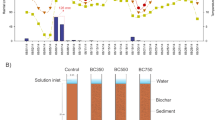Summary
The effects of heavy metals in diverse substrateamended river sediments were studied. Cd2+, Pb2+ and Zn2+ generally had a marked inhibitory effect on the synthesis of amylase, cellulase and urease, on numbers of substrate-hydrolysing bacteria, in all sediments studied. Inhibition increased with increasing metal concentration, and amylase was particularly sensitive. Pb2+ generally had the least effect. We conclude that enzyme synthesis measurements are useful in determining the effects of heavy metals on the degradation of organic pollutants in river sediments.
Similar content being viewed by others
References
Cole MA (1977) Lead inhibition of enzyme synthesis in soil. Appl Environ Microbiol 33:262–268
Douglas LA, Bremner JM (1970) Extraction and colorimetric determination of urea in soils. Soil Sci Soc Am Proc 34:859–862
Duddridge JE (1980) Effects of heavy metals on microbial populations and associated enzyme activities in river sediments. Ph.D. Thesis, University of Sheffield England
Duddridge JE, Wainwright M (1980) Effect of sodium chloride on enzyme activity and synthesis in river sediments. Environ Technol Letters 1:319–326
Duddridge JE, Wainwright M (1981a) Enzyme activity measurements as a means of assessing a river sediment's ability to degrade organic pollutants. Envrion Technol Letters 2:75–80
Duddridge JE, Wainwright M (1981b) Heavy metals in river sediments — calculation of metal adsorption maxima using Langmuir and Freudlich isotherms. Environ Pollut (Series B) 2: 387–397
Duddridge JE, Wainwright M (1982) Enzyme activity and kinetics in substrate-amended river sediments. Water Res 16:329–334
Lloyd JB, Whelan WJ (1969) An improved method for enzymic determination of glucose in the presence of maltose. Anal Biochem. 3:467–470
Smith W, Roe JH (1949) A photometric method for the determination of α-amylase in blood and urine with use of the starchiodine colour. J Biol Chem 179:53–59
Tyler G (1981) Heavy metals in soil biology and biochemistry. In: Paul EA, Ladd JN (eds) Soil biochemistry, vol. 5. Marcel Dekker, New York, pp 371–414
Wainwright M, Duddridge JE, Killham K (1982) Assay of α-amylase in soil and river sediments — its use to determine the effects of heavy metals on starch degradation. Enzyme Microbiol Technol 4:32–34
Author information
Authors and Affiliations
Rights and permissions
About this article
Cite this article
Wainwright, M., Duddridge, J.E. Effects of heavy metals on enzyme synthesis in substrate-amended river sediments. European J. Appl. Microbiol. Biotechnol. 15, 241–245 (1982). https://doi.org/10.1007/BF00499964
Received:
Issue Date:
DOI: https://doi.org/10.1007/BF00499964




